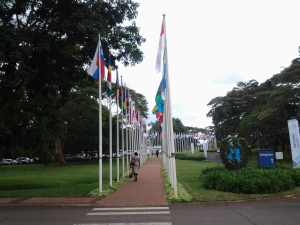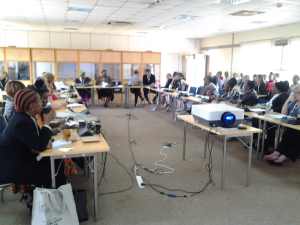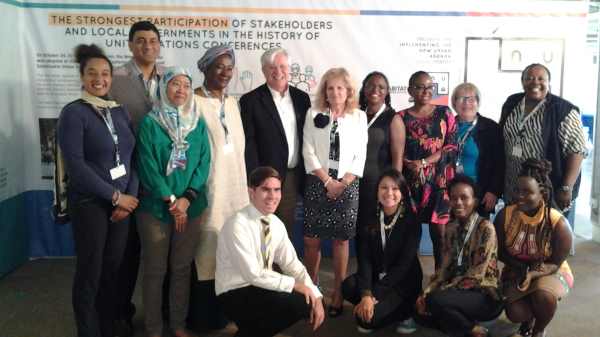News in 2017

|
UN-Habitat “Opportunities for the effective implementation of the New
Urban Agenda”
The 26th session of the UN Governing Council
6-12 May 2017, Nairobi, Kenya
 In May 2017, Vice President Diane Dumashie attended three partnership
meetings in Nairobi, Kenya to maintain engagement and strengthening
relationships for FIG with key International partners.
In May 2017, Vice President Diane Dumashie attended three partnership
meetings in Nairobi, Kenya to maintain engagement and strengthening
relationships for FIG with key International partners.

UN Habitat Complex, Gigiri, Nairobi, Kenya |
As a key meeting in the UN calendar, it was
accordingly, inaugurated by the President of Kenya, Mr Uhuru
Kenyatta, who delivered the keynote address, following
statements made by the Director General of the United Nations
office at Nairobi, Ms Sahle-Work Zwede, who also read out a
statement by the Secretary General of the UN, Mr Antonio
Guterres, followed by the Executive Director of UNEP and
Executive Director UN-Habitat.
https://unhabitat.org/governing-council/ |
Foremost, the
twenty-sixth session of the Governing Council of UN-Habitat took
place from 8 – 12 May 2017, at the United Nations Offices in
Nairobi, Kenya.This session of the Governing Council (GC)
comes at a crucial time,
following the adoption of the New Urban Agenda (NUA) at the Habitat III
meeting in Quito, Ecuador, in October 2016. (report
from Habitat III)
The NUA recognizes urbanization as a strategic issue for
development at national sub-national and local levels and consolidates
the vision of urbanization as a source of development. Importantly it is
now timely to move from adoption to action, which is well articulated by
the theme of the 26th session “Opportunities for the effective
implementation of the New Urban Agenda”.
The sub-themes for the GC26 are important to the FIG agenda, and
include: Towards inclusive, sustainable and adequate housing for a
better future (1),Synergies and financing for sustainable urbanization
(2) and Integrated human settlements planning for sustainable
urbanization (3).
Together member country states and relevant stakeholders met in Nairobi
to work to discuss define and adopt concrete ways and actions for the
implementation of the NUA. Noting that participation in the
GC is open to all, including parliamentarians, civil society
organizations, local authorities, professionals and researchers,
academia, foundations, women and youth groups, trade unions, indigenous
peoples organizations, financial institutions, and the private sector;
as well as organizations of the United Nations system and
Intergovernmental Organizations.
The GC is an intergovernmental decision-making body for UN–Habitat. It
meets biennially and reports to the General Assembly of the United
Nations, particularly on programmatic issues. Accordingly, other
key issues to be discussed at this meeting includes; the activities of
UN-Habitat, including coordination matters; review of the outcome of the
third United Nations Conference on Housing and Sustainable Urban
Development (Habitat III); and the work program and budget of
UN-Habitat for the biennium 2018-2019.
Notwithstanding, a hectic schedule of meetings, the UN, in keeping with
the NUA agenda and principles of sustainable transport provided cycles
to delegates to move around the UU Habitat complex .

Diane Dumashie and Jack from Slum dwellers Kenya, another GLTN
Partner |

Side event, Gender forum |
The meeting also gives a valuable opportunity for learning and exchange
during the numerous side events and to meet key FIG partners including:
The Gender Forum - attended by over 50 people, where representatives of a
range of women’s networks shared their experiences, importantly,
highlighting the importance of also engaging men in collective efforts
to achieve gender equality. Vice President D Dumashie
highlighted the existence of an emerging UN- Habitat Action Framework
designed to be used as a means to implement the NUA. And pointed
out that the recognition by UN Habitat of the central role of women
provides a true opportunity for women to continue the very good work.
This is often undertaken in discrete spheres; i.e. at grassroots,
professional and government officer circles, now is a time to listen,
engage with one another by combining our efforts across the spectrum of
women’s activities and to work together to ensure the implementation of
the urban agenda.
The government of Kenya - showcased their approach to implementing the
NUA, launching “Kenya’s Popular version of the NUA”
Developed by the Ministry of Housing, this Provides a simplified concise
version of the NUA. Photo - Side event, Gov of Kenya
CIS regions – Promoted case studies of sustainable urbanization in the
CIS region- where the Russian Minister of Construction, Housing and
Utilities joined a panel from Armenia, Tajikistan [Photo ]

Side event, Gov of Kenyar |

Chair Asa Johnson and CIS Panel |
The second formal meeting held on 7th May, and attended by Vice
President Diane Dumashie was the UN Habitat Advisory Board on Gender
Issues (AGGI) of which she has been a member for the past 5 years.
Established as an independent advisory board to the UN-Habitat Executive
Director, it seeks to advance women’s empowerment and gender equality in
sustainable urban development, and recognizing and supporting women as
active contributors to human settlements and urban development.
The meeting agreed to re-populate the Board members and to adopt an
operational strategic framework (authored by D Dumashie)

AGGI Board, with Executive Director UN Habitat Jon Clos – standing fifth from
the left
The third formal meeting involved FIG Vice President D Dumashie,
representing FIG, as a member of the Habitat Professional Forum (HPF). This meets at each GC, and provides a special forum for professionals
involved in land and property disciplines to meet, propose and implement
activities at UN Habitat platforms such as GC’s World Urban Forum events
and make recommendations to the Executive Director of U N Habitat. The meeting agreed a strategy of working for the next 2 years and to
hold an event at the next UN Habitat World Urban Forum scheduled in
February 2018, to be held in Malaysia.
Diane Dumashie
May 2017


























 In May 2017, Vice President Diane Dumashie attended three partnership
meetings in Nairobi, Kenya to maintain engagement and strengthening
relationships for FIG with key International partners.
In May 2017, Vice President Diane Dumashie attended three partnership
meetings in Nairobi, Kenya to maintain engagement and strengthening
relationships for FIG with key International partners. 



